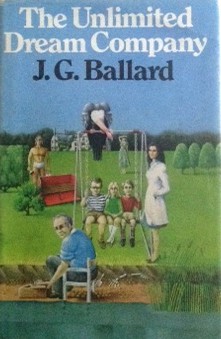Inspiring Older Readers
 posted on 28 Dec 2017
posted on 28 Dec 2017
The Unlimited Dream Company by J.G. Ballard
Most critical appraisals of J.G. Ballard’s work tend to see The Unlimited Dream Company as something of an outlier in his oeuvre. Unlike his more famous dystopian novels that imagine a world destroyed by environmental catastrophe or psycho-social breakdown, this one is euphoric and visionary and perhaps heavily influenced by his beloved surrealism.
Ballard shuns the structure and expectations of a conventional novel format and instead produces something more akin to an adult fairy tale or fable. In fact it might be better described as a creation myth told in a series of short, hallucinatory chapters in which fantasy and reality become increasingly hard to keep a grip on. There whole confection wouldn’t feel out of place in the drug-fuelled pantheon of hippydom – vivid colours whirl and swirl, huge prehensile plants shoot out of the ground, humans merge with animals and the constant themes of water and air dominate.
All of this is built on the rather mundane premise of a newly qualified pilot who crashes his Cessna plane in the river near the town of Shepperton, home of the famous film studios. This is when events start to spiral into the realms of the unreal as the pilot, Blake, emerges from the drowned plane seemingly still alive and with bruises on his chest that suggest someone saved his life with artificial respiration – although no-one seems to own up to this. There also seems to be some doubt about how long he was in the river – but he’s there and seemingly alive.
However, very quickly it becomes clear that there’s something else going on here. He discovers that however hard he tries, he’s unable to escape the boundary of the town and that he’s increasing obsessed with his potency and sexuality. He’s drawn to everyone with an overwhelming sexual urge – even inappropriately to children – and is soon having extraordinary dreams and encounters. In his dreams he can fly and in flying merge with the flying spirits of other inhabitants in the town. As if to mirror his dreams, the town begins to fill with birds of all species.
Around him everything is transmuted, exotic flowers begin to bloom and all sorts of fish, fowl and beasts start to converge on the town turning it into a pulsating new Eden. It’s not long before his influence on the people of Shepperton is felt and they begin to treat him as some kind of prophet/saviour. He liberates them from their suburban sexual and social morality and teaches them to fly free and to no longer be slaves to materialism.
There is resistance to his message from a character called Stark who attempts to kill him but the townspeople sacrifice their essence to heal him and at the end all have risen, taken flight, left the boundaries of their Earthly realm and set out to take the message of liberation elsewhere.
As with a book like Crash, Ballard isn’t shy about making his readers confront some difficult, even taboo issues and we’re never quite certain how we should be responding. Leaving aside the overt (sometimes rather embarrassing) descriptions of Blake’s sexual behaviour, current day readers will be discomforted by the way in which child sexuality is dealt with and will almost certainly be made uneasy by the way three disabled children at the centre of the story are often talked about. But I think it’s important to say that I don’t think any crude or simple perversity is at the heart of Ballard’s tale but he certainly uses language we'd find hard to live with today.
For me there is an obvious clue to what the author is doing here and it lies in the name of the central character, Blake. This is an clear reference to the poet William Blake and especially Blake's extended poem The Marriage of Heaven and Hell. The poet believed that the way to percieve God was to listen to our inner nature and to insist on freedom from the overweening, destructive, nature-denying morality of formal religion . This he claimed was the key to opening the doors of perception. What the aviator Blake in this story offers is a blurring of the boundaries between life and death, between ‘civilisation’ and nature and a lifting of the curtain on what is really real.
The Blake of this story is both alive and dead at the same time; transfigured by letting go of the normal parameters we impose on what is real and what is illusion or dream.
It’s also significant that Shepperton was Ballard’s home town and it does seem to be a reasonable assumption that some part of this fable is about the role of the artist or author. In some ways Blake is Ballard enabling his fellow Shepperton residents to rise free through the creativity of his imagination.
This is a complex book set in what seems to be a simple framework. Don’t let what can seem to modern readers the sometimes dated and even clumsy language get in the way because this is really a novel of ideas. Writing in The Guardian in 2014, critic John Grey chose this book as his favourite by Ballard and I very much like his assessment:
Blake's Shepperton is the world as it could be if the doors of perceptions were ripped from their hinges. The world Blake sees is shaped by unfettered human desire, a creation of the imagination in which the imperatives of society and morality count for nothing.
The book is in print in a paperback edition from Paladin and very cheap but the 1979 first edition will cost you something over £30 in decent condition.
Terry Potter
December 2017